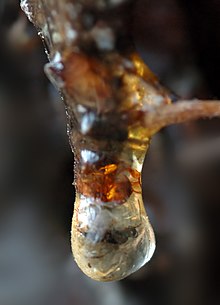
Back Hars Afrikaans راتنج Arabic Resina AST Papaskiw (irinacitc) ATJ Qatran Azerbaijani کیتیرگه AZB Ыҫмала Bashkir Baambeech BAR Смала Byelorussian Смола Bulgarian


A resin is a solid or highly viscous liquid that can be converted into a polymer.[1] Resins may be biological or synthetic in origin, but are typically harvested from plants. Resins are mixtures of organic compounds, and predominantly terpenes. Well known resins include amber, hashish, frankincense, myrrh and the animal-derived resin, shellac. Resins are commonly used in varnishes, adhesives, food additives, incenses and perfumes.
Resins protect plants from insects and pathogens, and are secreted in response to injury.[2] Resins confound a wide range of herbivores, insects, and pathogens, while the volatile phenolic compounds may attract benefactors such as predators of insects that attack the plant.[3]
- ^ "resin". IUPAC Compendium of Chemical Terminology. 3.0.1 (3rd ed.). International Union of Pure and Applied Chemistry. 2019. doi:10.1351/goldbook.RT07166.
- ^ "Resins". www.fs.fed.us.
- ^ "Plant Resins: Chemistry, evolution, ecology, and ethnobotany", by Jean Langenheim, Timber Press, Portland, OR. 2003